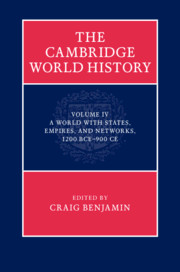
- Cited by 2
-
Cited byCrossref Citations
This Book has been cited by the following publications. This list is generated based on data provided by Crossref.
Salvatore, Armando Arnason, Johann P. Rahimi, Babak and Tottoli, Roberto 2018. The Wiley Blackwell History of Islam. p. 1.
Denecke, Wiebke 2019. A Companion to World Literature. p. 1.
- Publisher:
- Cambridge University Press
- Online publication date:
- May 2015
- Print publication year:
- 2015
- Online ISBN:
- 9781139059251
- Subjects:
- American History: General Interest, British History: General Interest, Regional and World History: General Interest, History, Regional History Before 1500, Global History
- Collections:
- Cambridge Histories - Global History, Cambridge Histories - Ancient History & Classics, Cambridge Histories - British & European History, Cambridge Histories - American History, Cambridge Histories - Asian History, Cambridge Histories - Middle East & African Studies
- Series:
- The Cambridge World History


